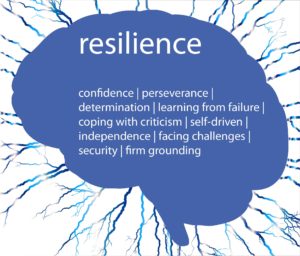 A post-lockdown repair kit
A post-lockdown repair kit
After what we hope will be the final lockdown many children will have become disconnected from their former patterns of learning.
Even the keenest are likely to have lost their edge of concentration while others will be feeling adrift and may appear unwilling to learn at all. Such signs of stress such as anxiety, recklessness, depression and self-doubt, are likely to show themselves, and learning for many will have become a challenge – their Resilience a casualty of lockdown.
We know from research that resilience is the foundation of emotional tolerance and that without resilience in one form or another, learning is impossible.
But research also shows that a resilient frame of mind can be nurtured and developed by engaging classroom cultures tended by thoughtful teachers. It takes time but the sooner it starts the sooner the benefits start to show, with often surprising quick wins.
Re-energising Your Learners’ Resilience is a simple-to-use online resource for teachers in any primary school anywhere.
The resource draws on ideas teachers have developed for building their students’ resilience. It offers every teacher rapid access to classroom-focused material that will help to re-energise, revive and develop students’ emotional learning behaviours.
A simple framework for a wide range of activity
Re-energising Your Learners’ Resilience addresses four aspects of Resilience in students. For each of those aspects, it offers four practical packages of ideas and activities; the packages focus in turn on four aspects of teaching practice.
The four-by-four framework is presented in a simple grid, illustrated below.
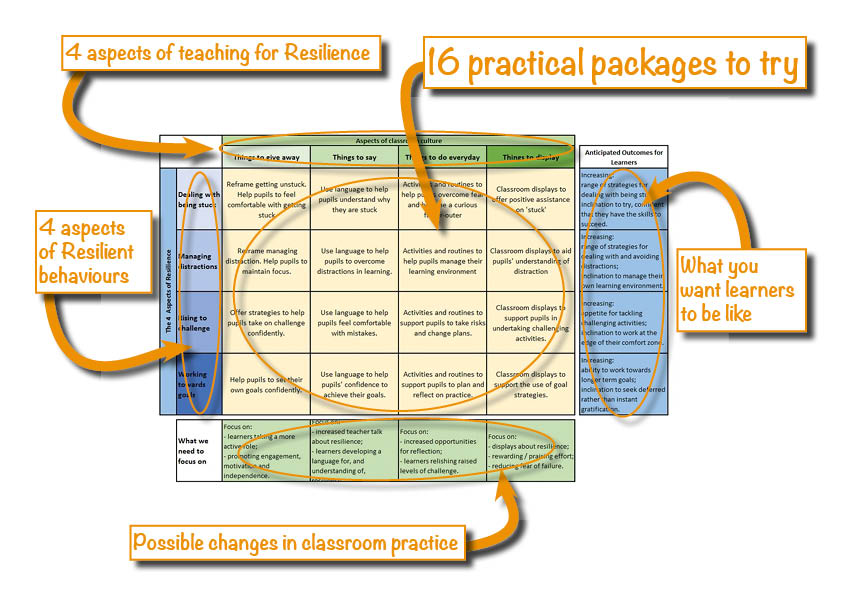
Each one of the sixteen yellow cells will take you into the corresponding section: there you will find five activities to choose from. The pattern of the five activities is consistent across all sixteen sections, so you will quickly become familiar with the approach.
You can see a complete example of these sections by opening the preview near the end of this page.
The four aspects of Resilience are
- Dealing with being stuck
- Managing distractions, ensuring continuing engagement with learning.
- Rising to challenge
- Working towards goals
Aspects of teaching and classroom culture are described as
- Things to give away: transferring responsibility for learning to students, offering them more control
- Things to say: using language that helps pupils understand learning as a process rather than a performance, and take more control of their own learning
- Things to do every day: examples of the kind of classroom routines and activities that will nurture resilient learners
- Things to display: the look and feel of a classroom, its walls and reward systems, that can serve to strengthen students’ resilience in learning.
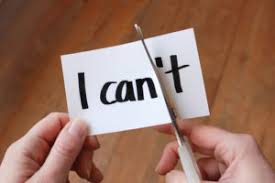
Seven questions (and answers)
1. How many activities/ideas does the resource give access to?
➡️ The resource has 80 big ideas. 20 for each aspect of re-energising resilience.
2. Is this just a load of worksheets?
➡️ Not a worksheet in sight! These ideas are about deeper and more exciting ideas rather than disposable child-friendly worksheets.
3. Who can use the resource?
➡️ At the school’s choice, we will enrol every classroom practitioner (teachers and support staff) in the school.
4. Are the ideas practical for all age groups across the school?
➡️ Yes, all the ideas come from and have been tried out in schools.
5. Will my school be able to afford it?
➡️ Yes, we think so — the price starts at £79 for a typical single-form entry primary school, rising to only £239 for the largest primaries.
6. How long will we have access — is it an annual subscription?
➡️ The resource will be available for 2 years, after which you can renew for a modest fee.
7. If we like these ideas, is there more of the same?
➡️ Yes indeed, this is just the tip of a big iceberg. Browse the ‘About BLP‘ and Professional Development pages for the big picture, or dip into Publications for more tasters.
Preview 1 of the 16 sections:
Section 11/16
Do every day: activities and routines to support rising to CHALLENGE
Excited by the prospect of tackling a challenge
About Challenge
Finding learning challenging is part and parcel of learning. Indeed when learning isn’t challenging it usually means we’re practising / consolidating what we can already do rather than breaking new ground. As learners we all come across challenges that cause us to think hard – the question is whether we are excited by the prospect of rising to the challenge, or daunted by the prospect of not being able to do so.
Having practical strategies to help us cope with challenge will lead us to think ‘Great, this is tricky and I’m going to give it a go’ or ‘Oh dear, this is too hard for me, I’ll give up’.
About Do Every Day
What you’re aiming to achieve is to design and deliver learning opportunities that strengthen students’ learning behaviours.
This involves making becoming a better learner the purpose of classroom; how classroom activities and routines feed learning habits. Learning challenges are designed to enable students to understand both the content and the process of learning. This dual focus stretches students’ use of their learning behaviours in order to explore and understand content. It’s not just about ‘doing’ learning but reflecting on the process to create self-regulated learners.
Engage your students in being able to rise to a challenge by:
Building greater willingness in students to change their plans.
Linking content with learning behaviours
Whether we realise it or not, all lessons have a dual purpose:
- The content dimension, with material to be mastered
- The ‘epistemic’ dimension, with some learning skills and habits being exercised.
In conventional lessons where the teacher remains the focus of attention and the initiator of all activity, and where the epistemic dimension is not acknowledged, students gain habits of compliance and dependence, rather than curiosity and self reliance. In developing resilient learning behaviours, teachers are making conscious choices about which habits to introduce and stretch and how best to couple these with content so that lessons become more interesting and challenging. Through such overt coupling of content and specific types of process, students come to know, understand and take control of their learning behaviours – they knowingly use and develop the whole range of learning behaviours. They become self-regulating learners.
A. Introduce
Give mistakes high status, a key role in learning:
- Say that you expect students to make, for example, 3 in a lesson. If they haven’t made the quota of mistakes they are to ask for harder work.
- Make a ‘Mistakes of the Week’ display.
- Identify ‘Good’ mistakes – as misconceptions and discuss them.
- Offer a range of examples of good mistakes as lesson starters for students to find and discuss.
- Model making mistakes and how you learn from them.
B. Model and explore
Couple content and process: build trial and improvement into lessons
Trial and Improvement; If students know we expect them to try things out, make slip-ups and have another go, their perception of being stuck is likely to turn to curiosity. Weave trial and improvement into lessons by, for example:–
- Include a trial and improvement success criterion when asking students to complete an activity or create a piece of work. For example: ‘I want to see evidence that you have tried and improved at least a couple of different layouts before settling on…’
- Include a designated focused trial and improvement time in lessons; time to test out ideas. Use scrap paper, mini whiteboards or rough books. Include opportunities for discussion to encourage editing, refining and clarifying of thinking
- Mark the working out that students do. Extend this common in maths idea across the curriculum.
Explore the meaning of effort
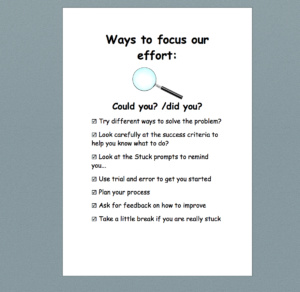
Effort is a word that teachers use frequently, but what does it mean? How might students decode this and begin to do it purposefully?
- Explore what is meant by ‘effort’ with your students, and discuss with them the ways in which they might apply it.
- Encourage them to come up with a definition of effort and specific examples of what it might look like in the classroom – for example by;trying different strategies to solve a problem,
- using a Visible Thinking Routine (VTR)
- aiming to achieve challenging goals, or
- using different un-sticking techniques when something is tricky.
- paying attention to whoever is speaking
Targeted Effort is now seen as a path to mastery. Students need to be aware of a connection between effort and improvement; that the sort of effort being used is causing their improvement. This is why it is important to give effort meaning. Meaning often underpins motivation which in turn drives behaviour.
C. Use
Enable students to select their own levels of challenge
Provide tasks that are designed to offer low, medium and high challenge (or cool, spicy, hot.) Allow students to decide on the level of challenge that they wish to undertake, and use it as an opportunity to encourage them to aim high.
- Use the Nando’s Peri-ometer as a visual aid to support the ranking of tasks by level of challenge, and allow students to select the level of challenge that they wish to undertake.

Embracing the hard bits
It’s the hard parts in learning that can cause demotivation in students accompanied by a greater likelihood of distraction. Students and teachers need to learn how best to cope with them.
Good work on the hard parts is a structural challenge for teaching as well as learning. We need to build in versions of ongoing assessment but assessment that is not concerned with marks /grades or evaluating the the how of learning. This is assessment designed to feed into the learning process and make the learning stronger. It’s possible to organise the rhythm of learning so that it embraces;
- deliberate practice
- assessment focused on understanding
- peer and self assessment
- communicative feedback
Teachers need to anticipate where the sticking points in the content are likely to be, the troublesome knowledge, and then ask;
- what standard ritual ways of thinking might get in the way?
- what do students know already that they might not have linked to this topic/knowledge/task?
- what is getting in the way of them thinking differently about this content to be able to assimilate it?
- what might they need to unlearn in order to relearn this content?
- which aspect(s) of the content is conceptually difficult
Here are researched ways of structuring work on the hard parts into the rhythm of the learning.
- Vary practice activities and conditions
- Interleave rather than block practice
- Break down complex problems
- Use low stake tests/quizzes with students
- Encourage students to self test
- Offer clues rather than solutions
4. Reflect on
Help students to know themselves as learners
- What’s happening?
- What am I seeing /noticing?
- How am I feeling / thinking about that?
- What else is happening?
- What’s changing?
- What’s going best/well?
- Do I need to do anything about any of this?
- What’s the most important thing that’s happened? Why?
- How was it significant?
- What difficulties did I meet?
- How did I resolve / sort them?
- Which strategies seemed effective?
- What else could we / I have done?
- How might it have been different?
Visible Thinking Routine
I used to think . . . . . Now I think.
This routine helps students to reflect on how and why their thinking/understanding is changing.
Remind students of the topic you have been working on. Ask them to respond to each of the sentence stems: I used to think…, Now, I think…
Alternatively ask students to write down their views at the beginning of a topic. Invite them to revisit & update their answer during and at the end in light of what has been learned.
Or, at the beginning of a lesson ask students to write down what they understand by a particular term that will be explored in the coming lesson (e.g. Phrase (English); Proof (Maths); Power (Science) etc). At the end of the lesson, ask them to write down what they now understand by the term.
5. Improve on
Design stretch challenges
When you design what we might call ‘stretch challenges’—ones that are designed to build your students’ relish for difficulty— it’s useful to ask yourself the following questions:
- How can I construct a problem-solving activity to enable students’ understanding of xyz content without telling them?
- How can I intrigue them with something that is open to several interpretations?
- What could I say/do/show to stimulate their curiosity?
- How can I make this grab their attention…visually and aurally?
- How long shall I allow them to stay stuck before I ask them how they are thinking?
- If they are well and truly stuck, what can I offer as a nudge to get them thinking differently that doesn’t give the answer away?
- Will I leave it as a problem hanging in the air to which we will return later?
- When will I ask them to make links between the challenge, and what and how we are learning in this lesson?
END OF PREVIEWED SECTION




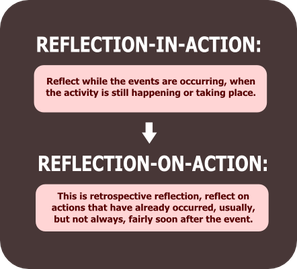

Comments are closed.